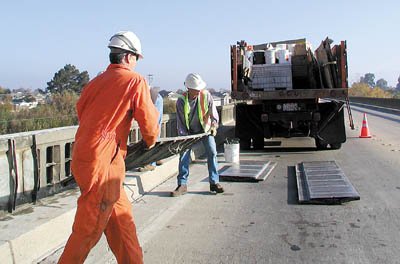
Motorists traveling across the San Benito River bridge on San
Juan Road were slightly inconvenienced Tuesday and Wednesday as
Caltrans crews made repairs on the westbound side of the bridge
where a vehicle crashed last month.
Motorists traveling across the San Benito River bridge on San Juan Road were slightly inconvenienced Tuesday and Wednesday as Caltrans crews made repairs on the westbound side of the bridge where a vehicle crashed last month, knocking out 27 feet of concrete railing.
Roland Santiago, 22, of Salinas was traveling east on the bridge at about 6 a.m. Nov. 8 when his vehicle reportedly hit a pool of standing water, causing it to veer to the left and hit the bridge railing. A section of the rail fell into the dry river bed.
The California Highway Patrol said Santiago was not drinking or using a cell phone at the time of the accident.
Caltrans crews used a two-step process to repair the rail during – putting the forms in place to pour the concrete, then removing them to finish the concrete work.
The cost for materials was less than $250, which is minimal compared to the labor costs, a Caltrans official said.
“It costs about $1,000 a day to run my crew,” said Buzzy Betts, a Caltrans bridge maintenance supervisor. “The cost is mostly in labor because it’s all hand work. We don’t use any type of machinery.”
The bridge was built in the 1950s and the forms used to repair it this week were made at the same time at a cost of $65. At Caltrans’ main yard in San Luis Obispo, railing forms are stored, some dating back to the 1930s.
“A lot of them are from the ’30s and ’60s that I use to repair the bridges in territory I cover,” said Betts, whose crew maintains 800 state bridges from Santa Cruz to Santa Barbara.
“Other people may build them, but when they’re done it’s mine,” he said. “I get them because that’s what I do – I repair bridges.”
Caltrans inspects all state bridges every two years.
Bridges on state highways are designed to move on rocker bearing surfaces to help absorb the force of continuous vehicle travel and California’s seismic ground movement.
Betts said most people think that once a bridge is built they can forget about it.
“But they’re alive,” he said. “They need to be cleaned and maintained to be healthy.”









